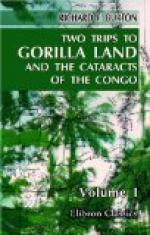“Between the tropical limits and the equator, however, the sun comes twice to the zenith of each place. If now, between the going and coming of the sun, from the Line to its furthest range, a sufficient pause intervenes, or if the sun’s temporary distance from the zenith is great enough, the rainy season is divided into two portions, separated by a lesser dry season. Closer to the tropical lines, where the sun remains but once in the zenith, the rainy season is a continuous one.”
Such is the theory of the “Allgemeine Erdkunde” (Hahn, Hochstetter and Pokorny, Prague, 1872). An explanation should be added of the reason why the cool wind ceases to blow, at the time when the air, heated and raised by a perpendicular sun, might be expected to cause a greater indraught. We at once, I have said, recognize its correctness at sea. The Gaboon, “in the belt of calms, with rain during the whole year,” has two distinctly marked dry seasons, at the vernal and the autumnal equinoxes. The former or early rains (Nchangya?) are expected to begin in February, with violent tornadoes and storms, especially at the full and change, and to end in April. The heavy downfalls are mostly at night, possibly an effect of the Sierra del Crystal. I found March 28th (1862) very like damp weather at the end of an English May; April 6th was equally exceptional, raining from dawn to evening. During my trip to Sanga-Tanga and back (March 25th to 29th) we had frequent fogs, locally called “smokes,” and almost daily tornadoes, sometimes from the south-east, whilst the lightning was dangerous as upon the Western prairies. After an interval of fiery sun, with occasional rain torrents and discharges of electricity, begin the Enomo (Enun?), the “middle” or long dries, which last four months to September. The “Enomo” is the Angolan Cacimbo, meaning cool and cloudy weather, when no umbrella is required, and when the invariably grey sky rarely rains. Travellers are told that June and July are the cream of the year, the healthiest time for seasoned Europeans, and this phantom of a winter renders the climate more supportable to the northern constitution.
During the “middle dries,” when the sun, retiring to the summer solstice, is most distant, land winds and sea breezes are strong and regular, and the people suffer severely from cold. In the Gaboon heavy showers sometimes fall, July being the least subject to them, and the fiery sun, when it can disperse the clouds, turns the soil to dust. At the end of September appear the “latter rains,” which are the more copious, as they seldom last more than six hours at a time. It is erroneous to assert that “the tract nearest the equator on both sides has the longest rainy season;” the measure chiefly depends upon altitude and other local conditions.




